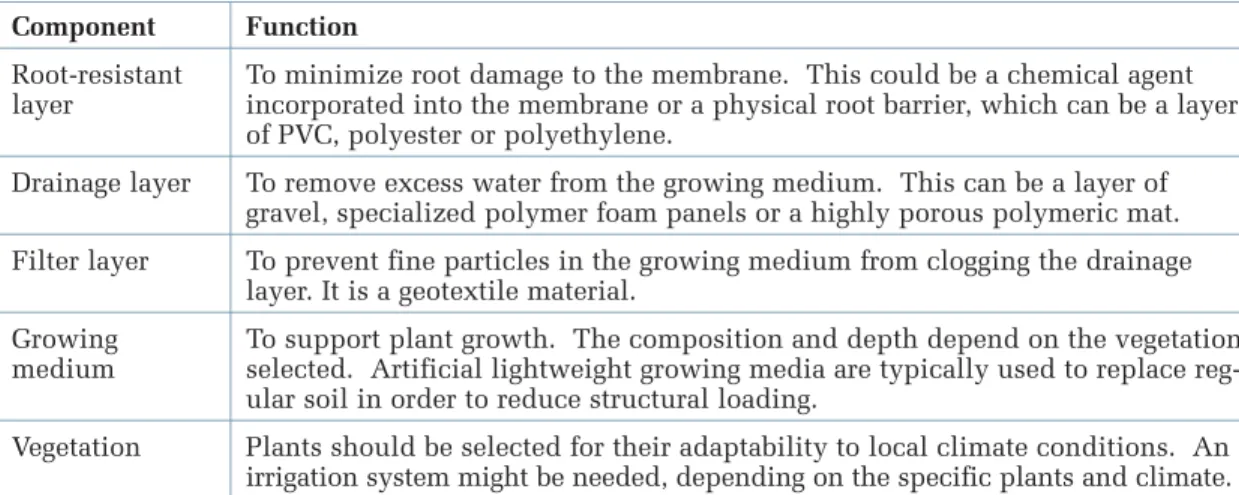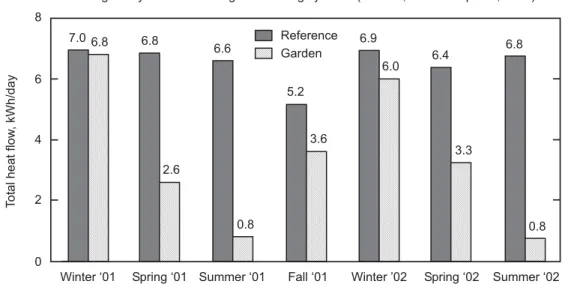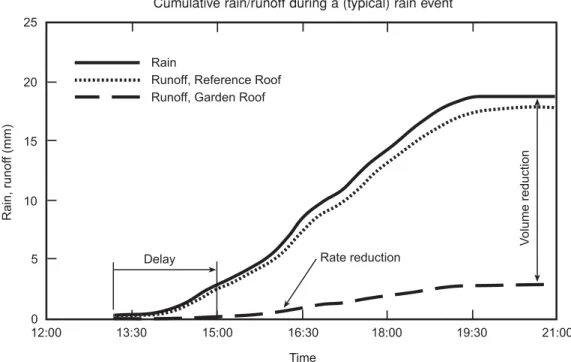Publisher’s version / Version de l'éditeur:
Construction Technology Update, 2005-09-01
READ THESE TERMS AND CONDITIONS CAREFULLY BEFORE USING THIS WEBSITE.
https://nrc-publications.canada.ca/eng/copyright
Vous avez des questions? Nous pouvons vous aider. Pour communiquer directement avec un auteur, consultez la
première page de la revue dans laquelle son article a été publié afin de trouver ses coordonnées. Si vous n’arrivez pas à les repérer, communiquez avec nous à PublicationsArchive-ArchivesPublications@nrc-cnrc.gc.ca.
Questions? Contact the NRC Publications Archive team at
PublicationsArchive-ArchivesPublications@nrc-cnrc.gc.ca. If you wish to email the authors directly, please see the first page of the publication for their contact information.
NRC Publications Archive
Archives des publications du CNRC
Access and use of this website and the material on it are subject to the Terms and Conditions set forth at
Using garden roof systems to achieve sustainable building envelopes
Liu, K. K. Y.; Baskaran, B. A.
https://publications-cnrc.canada.ca/fra/droits
L’accès à ce site Web et l’utilisation de son contenu sont assujettis aux conditions présentées dans le site LISEZ CES CONDITIONS ATTENTIVEMENT AVANT D’UTILISER CE SITE WEB.
NRC Publications Record / Notice d'Archives des publications de CNRC:
https://nrc-publications.canada.ca/eng/view/object/?id=c95f042f-c32c-44b1-9e11-6055eadff533 https://publications-cnrc.canada.ca/fra/voir/objet/?id=c95f042f-c32c-44b1-9e11-6055eadff533
C o n s t r u c t i o n T e c h n o l o g y U p d a t e N o . 6 5
Garden roofs, sometimes known as green roofs or rooftop gardens, are specialized roof systems that support vegetation growth. With technical advances in roofing materials and components, garden roof systems can
now be successfully installed in most climates, providing an attractive design option, especially in urban areas where land available for parks and green space is limited. As well, concern about sustainability and
climate change have led to increased interest in garden roofs as a possible means of helping address these issues. However, while garden roofs are increasing in popularity, there is little infor-mation on their performance in cold climates.
What Constitutes a Garden Roof?
Garden roofs, which can be installed on both conventional and protected-membrane roofing systems (see Figures 1 and 2), require additional components, such as a root-resistant layer, a drainage layer, a filter membrane and a growing medium, to support the growth of vegetation. Typical components and their functions are summarized in Table 1. Garden roofs are gener-ally considered to be “intensive” or “extensive,” based on the weight of the system (Table 2).
By K.Y. Liu and A. Baskaran
There is increasing interest in the garden roof system as a sustainable building
design option in North America today. This Update reports the results of a
field study to evaluate the thermal performance of this technology, as well as
its potential to retain storm water runoff.
Using Garden Roof Systems
to Achieve Sustainable
Building Envelopes
Figure 1.Conventional roofing system (a) with and (b) without a garden roof system.
Growing medium Drainage layer Filter layer Waterproof membrane Deck Vegetation Cover board Thermal insulation Vapour barrier
Root-resistant layer Waterproof membrane
Deck Cover board
Thermal insulation Vapour barrier
Figure 2.Protected membrane roofing system (a) with and (b) without a garden roof system. Growing medium Filter layer Drainage layer Filter layer Thermal insulation Waterproof membrane Deck Vegetation Root-resistant layer Ballast / Paver Separation layer Thermal insulation Waterproof membrane Deck Filter layer
Intensive garden roof systems are relatively heavy, with deep soil to support a wide variety of small trees and shrubs. They require a high level of maintenance. Because of the high structural loading involved, intensive garden roofs are normally incor-porated into the original building design.
Extensive garden roof systems have a shallow, lightweight growing medium, which can support only small plants such as herbs, grasses and wild flowers. They are intended to be low maintenance, and therefore require plants that are hardy, draught tolerant and preferably self-generating. Because the structural loading demands are low, many existing buildings can be retrofitted to accommodate extensive systems.
2
Experimental Study
In order to learn more about the performance of garden roofs, NRC-IRC constructed a field roofing facility at its Ottawa campus. This facility is a low-slope industrial roof of about 72 m2. The roof is divided into two equal sections with an extensive garden roof with grass growing in 150 mm of light-weight growing medium on one half and a modified bituminous roofing assembly on the other (the reference roof). The two sections have the same basic components up to the membrane level, representing a conventional roofing system commonly used in Canada; however, the garden roof incorporates additional elements to support plant growth (Figure 1).
Table 1.Typical additional components and their functions in a garden roof system.
Component Function
Root-resistant To minimize root damage to the membrane. This could be a chemical agent layer incorporated into the membrane or a physical root barrier, which can be a layer
of PVC, polyester or polyethylene.
Drainage layer To remove excess water from the growing medium. This can be a layer of gravel, specialized polymer foam panels or a highly porous polymeric mat. Filter layer To prevent fine particles in the growing medium from clogging the drainage
layer. It is a geotextile material.
Growing To support plant growth. The composition and depth depend on the vegetation medium selected. Artificial lightweight growing media are typically used to replace
reg-ular soil in order to reduce structural loading.
Vegetation Plants should be selected for their adaptability to local climate conditions. An irrigation system might be needed, depending on the specific plants and climate. Table 2.Classification of garden roof systems by loading requirements.
Loading
Typical Typical depth of
weight of growing Features and Level of
Classification system medium functions maintenance Accessibility
Extensive <300 kg/m2 <200 mm Provides Low maintenance— Limited—
ecologically little or no irrigation seldom beneficial setting; needed when entered can be viewed plants have been except for from above or established. maintenance
from surrounding purposes.
buildings.
Intensive >300 kg/m2 >200 mm Provides complete High maintenance— Accessible—
garden or park- irrigation and provides like features regular garden green spaces
maintenance for occupants required
Both the garden roof and the reference roof are instrumented to measure the following:
• storm water runoff
• temperature (measured at different layers within the roof system and growing medium)
• heat flow across the roof system • solar reflectance of the roof surface • soil moisture content
• rooftop microclimate
Local meteorological conditions such as temperature, relative humidity, rainfall and solar radiation are also monitored continu-ously by one weather station located on the median divider on the rooftop and another situated approximately 50 m from the site. All sensors and instrumentation are connected to a data-acquisition system. Results, Findings and Implications The data collected at the research facility during the first 22 months (November 2000– September 2002) of operation have been analyzed and are summarized below. Temperature Profiles and Fluctuations
Roofing membranes can be negatively affected by heat exposure, which can accelerate aging in the roofing materials, reducing their durability. Temperature fluctuations can induce thermal stresses in these materials, thus affecting the integrity of the roofing system. In addition, ultra
violet radiation can alter their chemical composition and degrade their mechanical properties.
The membrane of the reference roof experienced significantly higher tempera-tures than the one on the garden roof, espe-cially in the warmer months. On a typical summer day, the exposed membrane on the conventional roof reached 70°C in the after-noon while the membrane of the garden roof remained at around 25°C. In the win-ter, the temperature profiles for the two roofs were similar because of the insulating effects of the snow coverage.
The membrane of the garden roof experi-enced significantly smaller daily tempera-ture fluctuations in the warmer months than the conventional roof. During spring and summer, the median daily temperature fluctuation of this membrane was 6°C com-pared to 45°C for the conventional roof membrane and was consistently lower than the median daily temperature fluctuation of the ambient air (Figure 3).
Clearly, garden roofs can lower the temperature and modify the temperature fluctuations experienced by the roofing membrane. The reduction in temperature can decrease the effects of heat on the roof-ing materials (premature deterioration), and the moderation in temperature fluctuations can decrease the thermal stress on the mem-brane. This slower rate of deterioration can Figure 3.Temperature measurements at the NRC-IRC roofing facility showed that the garden roof significantly reduced the daily temperature fluctuations experienced by the roofing membrane.
mean greater durability and an extended service life for the roof membrane. In addi-tion, garden roofs can protect the roofing membrane from exposure to ultra violet radiation and hail.
Heat Flow and Energy Efficiency
During the spring and summer, heat enters a building through the roof in the afternoon as a result of solar radiation and doesn’t leave the building until the evening or early morning. This creates a demand for cooling in the building.
In the summer, the heat flow through the reference roof created an average daily energy demand for space conditioning of 6.5–7.0 kWh/day (Figure 4). However, this energy demand was reduced to less than 1.0 kWh/day in the garden roof—a reduc-tion of over 75%, which can be attributed to the presence of the growing medium and the plants.1-3 These heat-flow values are for the roof only and not for other building envelope components.
The garden roof was more effective in controlling heat gain in the spring and sum-mer than in reducing heat loss in the fall and winter because of the various thermal mechanisms involved—shading, insulation, evapotranspiration and thermal mass. During the observation period, the garden roof reduced heat gain by 95% and heat loss by 26%, with an overall reduction in heat flow of 47% compared to the conventional roof.
Because Ottawa is in a region where the need for heating rather than cooling pre-dominates, the energy savings derived from the use of garden roofs are likely to be rela-tively small. However, in warmer regions where cooling rather than heating is the main concern, they could be significant.
In general, the energy savings realized with garden roof technology would depend on the climate, the type of heating/cooling mechanisms used in the building, and their particular efficiencies, and the energy sources, which are site specific. However, any reduction in energy demand means a reduction in the green house gas emissions associated with the production of that energy, resulting in positive effects on cli-mate change and the environment. Retention of Storm Water Runoff
During a rain storm, water rushes off impermeable surfaces such as rooftops and pavements into the storm sewers, causing a sudden surge in the storm water infra-structure. When the amount of runoff exceeds the capacity of the storm sewers, flash floods, and sometimes combined sewage overflows (where water from the storm sewers overflows into the sanitary sewers), can occur, causing environmental and health problems.4
4 Construction Technology Update No. 65
Figure 4.Energy measurements at the NRC-IRC roofing facility showed that the garden roof significantly reduced the average daily heat flow through the roof in the spring and summer.
The garden roof delayed storm water runoff, and reduced the peak runoff rate and volume. Figure 5 shows the runoff from both roof areas during a rainfall of 19 mm over 6.5 hours. On the garden roof, the delay in runoff was 95 minutes and the runoff volume was 2.9 mm, a reduction in volume of 85%. Over the course of a year (2002), the garden roof retained (and diverted through evaporation and evapotranspiration) 245 mm of the 450 mm of rain that fell from April through September, an overall reduction in runoff of 54%. It is likely that garden roof systems designed with deeper and more absorbent soil, as well as more vegetation, would retain even more storm water than the system tested by the NRC-IRC researchers.
If the impermeable rooftop of a conven-tional roof were covered with a permeable layer, this would delay runoff, and reduce the peak flow and total volume going into the sewage system. Thus the “rush hour” in the storm sewer at the beginning of the storm would be avoided, while the reduc-tion in total volume would lessen the load on the sewage infrastructure. The extent of the reduction of storm water runoff when garden roof systems are used depends on
many factors such as the intensity of the rain and its duration, and the moisture content of the growing medium before the rain started.
Summary of Potential Benefits Analysis of the data collected from the roof-ing facility demonstrated that garden roofs: • can lower the temperature and modify
the temperature fluctuations experienced by the roofing membrane, thereby pro-longing its service life.
• can modify heat flow, thereby reducing energy demands for space conditioning, through direct shading of the roof, evap-otranspiration and the improved insula-tion values provided by the growing medium and vegetation.1-3
• are more effective in reducing heat gain in the summer than heat loss in the win-ter because of the thermal mechanisms involved (shading and evapotranspira-tion), thereby offering the potential of energy savings in climates where cooling is required.
• can delay storm water runoff, thereby reducing peak flow and total volume going into the storm sewers.
Figure 5.Runoff recorded at the NRC-IRC roofing facility during a rain event showed that the garden roof delayed the runoff, and reduced the flow rate and total discharge volume.
“Construction Technology Updates” is a series of technical articles containing practical information distilled from recent construction research.
For more information, contact Institute for Research in Construction, National Research Council of Canada, Ottawa K1A 0R6
Telephone: (613) 993-2607; Facsimile: (613) 952-7673; Internet: http://irc.nrc-cnrc.gc.ca
© 2005
National Research Council of Canada September 2005
ISSN 1206-1220
Garden roof systems are specialized systems that must be carefully designed. During their construction it is important to coordinate among the various trades. As well, it is recommended that a leak detec-tion test be performed on the membrane both before and after the installation of the overburden (the growing medium and vege-tation). Building owners also need to be aware of and committed to the work and costs required to maintain such a system. References
1. Christian, J.E. and Petrie, T.W. Sustainable Roofs with Real Energy Savings,
Proceedings of the Sustainable Low-Slope Roofing Workshop, ed. Desjarlais, A. Oak Ridge National Laboratory, Oak Ridge, TN, 1996, p. 99.
2. Eumorfopoulou, E. and Aravantinos, D. The Contribution of a Planted Roof to the Thermal Protection of Buildings in Greece, Energy and Buildings, 27:29-36, 1998.
3. Palomo Del Barrio, E. Analysis of the Green Roofs Cooling Potential in Buildings,
Energy and Buildings, 27:179-193, 1998.
4. Environmental Building News, November 2001, p. 11.
Dr. Karen Liu is a researcher in the Building Envelope program at the National Research Council’s Institute for Research in Construction. Dr. A. Baskaran is a senior researcher in the same program.
Rooftop Garden Consortium at NRC
The members of the Rooftop Garden Consortium, who have provided financial support and technical expertise in this study, are: Bakor, Canadian Roofing Contractors’ Association (CRCA), EMCO, Environment Canada, Garland, Hydrotech, IKO Industries, Public Works and Government Services Canada (PWGSC), Roof Consultants Institute (RCI), Soprema Inc., Tremco; Oak Ridge National Laboratory (ORNL) and the Climate Change Action Fund (CCAF).



